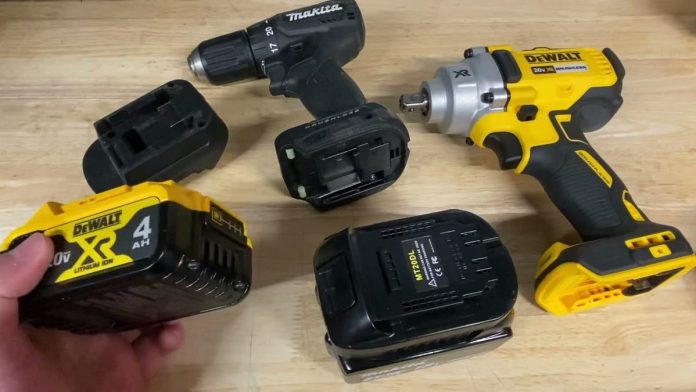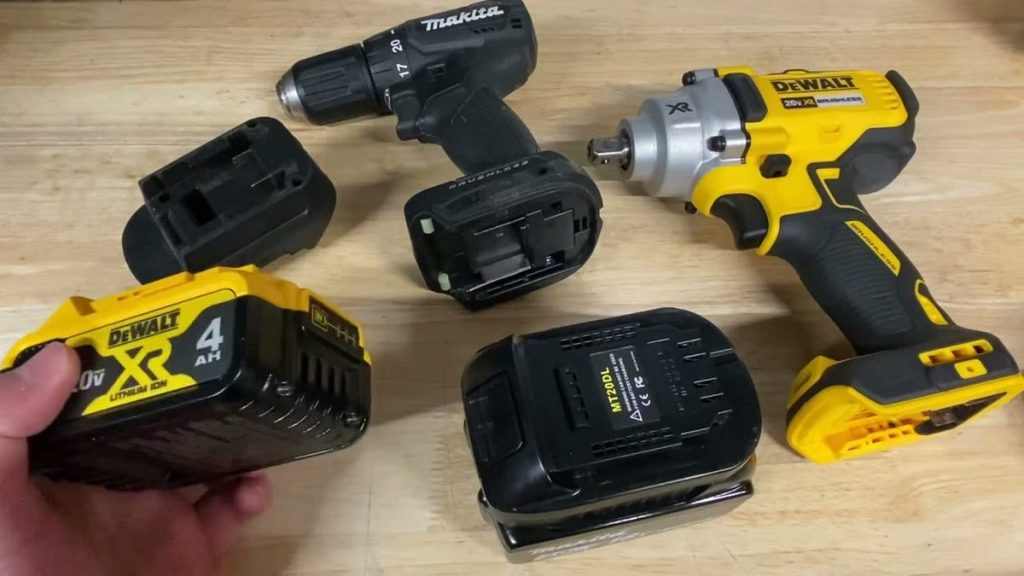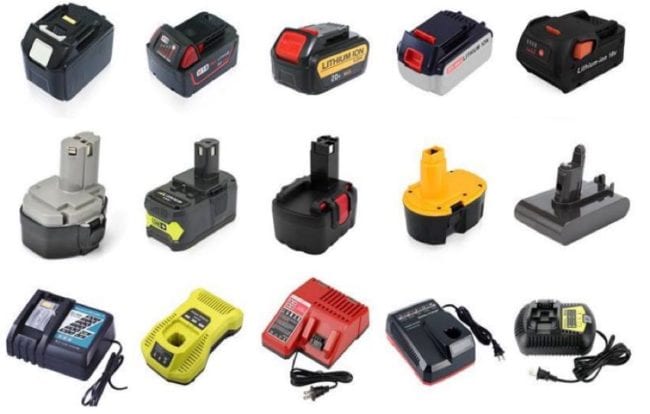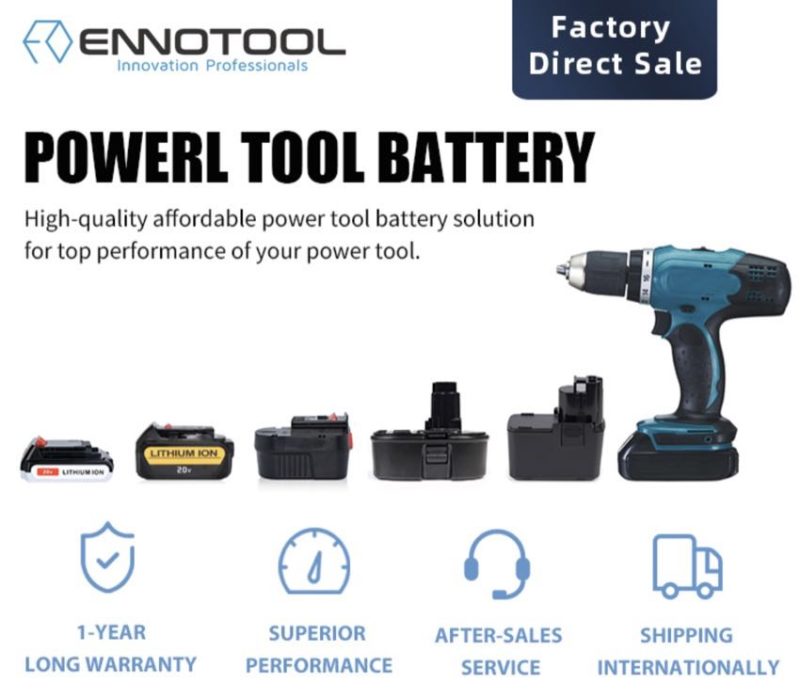Have you ever found yourself wondering if you can use the same battery for multiple cordless tools from the same brand? Well, in this article, we’ll explore the possibility of using one battery interchangeably across various cordless tools. If you’re a fan of cordless convenience and enjoy the versatility that cordless tools offer, then this is definitely an article you won’t want to miss. So, let’s dive in and find out if you can power up all your favorite tools with just one battery!
Understanding Battery Compatibility
Compatibility between Tools and Batteries
When it comes to cordless tools, one key consideration is the compatibility between tools and batteries. As a consumer, it’s important to ensure that the battery you have for one cordless tool can be used with other tools from the same brand. This compatibility allows for seamless interchangeability and convenience in your DIY or professional projects.
Benefits of Using the Same Battery for Multiple Tools
Using the same battery for multiple cordless tools from the same brand offers several advantages. Firstly, it eliminates the need to purchase multiple batteries for each tool, saving you both money and storage space. Additionally, it simplifies your tool collection by reducing the number of different batteries you need to keep track of and maintain.
Furthermore, using a single battery across various tools promotes efficiency. Swapping batteries between tools becomes effortless, allowing for uninterrupted workflow and completing tasks in a shorter amount of time. This convenience can be particularly beneficial for professionals who rely on their cordless tools for regular and demanding work.
Factors Affecting Compatibility
While the idea of using the same battery for multiple tools may seem straightforward, there are factors that can affect compatibility. One such factor is the voltage level of the battery. Different tools require different voltage levels, and using an incompatible battery can lead to poor performance or even damage to the tool.
Another factor to consider is the battery chemistry. Lithium-ion batteries, for example, have become the standard for cordless tools due to their higher energy density and longer lifespan. However, some older tools may still use Ni-Cd or Ni-MH batteries, which are not compatible with lithium-ion batteries. It’s important to check the battery chemistry requirements of your tools to ensure compatibility.
Finally, the ampere-hour (Ah) rating of a battery can also impact compatibility. Higher Ah ratings generally indicate a longer runtime, but some tools may have limitations on the maximum Ah rating they can use. Using a battery with a higher Ah rating than what the tool can handle may cause overheating or other issues. Always consult the tool’s manual for guidance on compatible Ah ratings.
Interchangeability within a Brand
Advantages of Using a Single Brand for Cordless Tools
Using tools from a single brand offers several advantages when it comes to battery interchangeability. One significant advantage is that brands often design their tools and batteries to be compatible with each other, making interchangeability seamless. When you stick to a single brand, you can be confident that the battery you have will work with all the tools in that brand’s lineup.
Furthermore, using tools from a single brand can provide a consistent user experience. Brands often design their tools with similar features, ergonomics, and controls, which can make switching between tools feel familiar and intuitive. This can enhance efficiency and productivity, especially when working on complex projects that require multiple tools.
Compatibility Guarantee within a Brand
Brands generally offer a compatibility guarantee within their product line. This means that if you purchase a new tool from the same brand, your existing battery should be compatible with it. This guarantee gives you peace of mind when expanding your tool collection. You can confidently invest in additional tools without the worry of having to purchase additional batteries.
Exceptions to Interchangeability
While most brands strive to ensure interchangeability within their product line, there may be exceptions. Occasionally, brands release new tools that require a different battery platform due to advancements in technology or specific design requirements. It’s essential to research and confirm compatibility before purchasing any new tools to avoid any surprises.
This image is property of corporate.homedepot.com.
Battery Platform Systems
Introduction to Battery Platform Systems
Battery platform systems refer to a standardized system of batteries and chargers that can be used interchangeably across multiple cordless tools. In contrast to using a single brand’s battery, battery platform systems offer compatibility between brands. This means that you can use the same battery across different brands’ tools as long as they support the same platform.
Benefits of Battery Platform Systems
One of the primary benefits of battery platform systems is the flexibility they provide. With a compatible battery platform, you can choose from various brands and tool models, without the need to invest in multiple batteries and chargers for each brand. This flexibility can be especially advantageous if you have a preference for specific tools from different brands.
Additionally, battery platform systems often support a wide range of tools, including drills, saws, impact drivers, and more. This enables you to build a versatile tool collection that suits your specific needs, regardless of the brand.
Limitations of Battery Platform Systems
While battery platform systems offer great flexibility, there are a few limitations to consider. Firstly, not all brands participate in battery platform systems. Therefore, if you have a strong affinity for a particular brand that doesn’t support the platform, you may not be able to take full advantage of the interchangeability.
Another limitation is that battery platform systems often require an adapter to be compatible with certain tools. This can add an extra layer of complexity and cost to your setup. It’s important to consider whether the benefits of using a battery platform system outweigh the potential drawbacks, depending on your specific needs and preferences.
Examples of Popular Battery Platform Systems
Some popular examples of battery platform systems include Makita’s LXT System, DEWALT’s 20V MAX System, and Milwaukee’s M18 System. These platforms have gained popularity due to their extensive tool offerings, compatibility guarantees, and the ability to use the same battery across multiple brands’ tools. Researching these platforms can give you a better understanding of the options available in the market.
Understanding Battery Models
Battery Model Numbers
Battery model numbers are alphanumeric codes assigned to specific battery types within a brand’s lineup. These model numbers provide information about the battery’s features, capacity, and compatibility. Understanding the structure and meaning of battery model numbers can help you determine whether a specific battery is compatible with your tools.
Determining Compatibility Using Model Numbers
To ensure compatibility using model numbers, it’s crucial to cross-reference the battery model numbers listed in your tools’ manuals or specifications with the battery model numbers available for purchase. If the model numbers match, you can have confidence that the battery is compatible with your tools. Be mindful of any suffixes or variations in the model numbers, as these can indicate slight differences in capacity or other features.
Manufacturers often provide comprehensive documentation or compatibility charts on their websites, which can assist you in finding the appropriate battery model numbers for your specific tools. It’s always a good idea to consult these resources to ensure the best compatibility.
This image is property of powuse.com.
Considerations for Mixing and Matching Tools
Compatibility Issues with Different Voltage Levels
When mixing and matching tools, it’s essential to consider the voltage levels of both the tools and the batteries. Different tools require specific voltage levels to operate optimally. Using a battery with a higher or lower voltage than what the tool is designed for can lead to reduced performance, overheating, or even damage.
For example, if you have a cordless drill that requires an 18V battery, using a 12V battery intended for a small hand tool could result in insufficient power for the drill’s functionality. On the other hand, using a higher voltage battery, such as a 24V battery, may put excessive strain on the drill’s motor and potentially cause it to fail.
To avoid compatibility issues related to voltage, it’s crucial to check the voltage requirements of your tools and ensure that the batteries you use match the specified voltage level.
Compatibility Issues with Different Battery Chemistries
Battery chemistry plays a vital role in compatibility. Different battery chemistries, such as lithium-ion, Ni-Cd, and Ni-MH, have varying characteristics and voltage outputs. Mixing batteries with different chemistries can lead to compatibility issues and potential damage to the tools and batteries.
For example, lithium-ion batteries have a higher energy density compared to Ni-Cd or Ni-MH batteries. If you use a lithium-ion battery in a tool designed for Ni-Cd or Ni-MH batteries, the tool may not deliver its full performance potential or could get damaged due to the difference in energy output.
To ensure compatibility, it’s important to use batteries with the same chemistry as specified by the manufacturer for your specific tools.
Compatibility Issues with Different Ah Ratings
Ampere-hour (Ah) rating refers to the capacity or runtime of a battery. Different tools have different power requirements, and using a battery with a significantly higher or lower Ah rating than what the tool is designed for can lead to compatibility issues.
Using a battery with a lower Ah rating than what the tool requires may result in reduced runtime and lower overall performance. Conversely, using a battery with a higher Ah rating can potentially overload the tool, causing excessive heat buildup or damage.
To determine the appropriate Ah rating for your tools, consult the tool’s manual or specifications. It’s crucial to use batteries with Ah ratings within the range recommended by the manufacturer to ensure compatibility and optimal performance.
Advantages of Using the Same Battery
Cost Savings
One of the significant advantages of using the same battery for multiple cordless tools is the cost savings it offers. Purchasing additional batteries for each tool can quickly add up, especially if you have a comprehensive tool collection. By using the same battery, you can avoid the need for multiple battery purchases, saving money that can be allocated elsewhere.
Additionally, using the same battery reduces the need for additional charging equipment. Instead of having multiple chargers for each battery, you can use a single charger for all your tools, further reducing costs and clutter.
Convenience and Efficiency
Using the same battery for multiple tools enhances convenience and efficiency. Instead of constantly swapping out batteries and interrupting your workflow, you can seamlessly transition between tools with a single battery. This eliminates the need to pause and search for a compatible battery, improving productivity and saving time.
When working on a project that requires multiple tools, having a unified battery system allows you to focus on the task at hand rather than managing batteries. With fewer distractions and interruptions, you can maintain a steady workflow and complete projects more efficiently.
Reduced Charging Equipment
By using the same battery for multiple tools, you can minimize the number of chargers and charging equipment required. Having fewer charging devices not only saves space but also simplifies the charging process. Instead of juggling multiple chargers and outlets, you can streamline your charging setup with a single charger. This reduces the chances of misplacing chargers or dealing with a tangled mess of cords.
Preventing Battery Drain
Using the same battery for all your cordless tools helps to prevent battery drain. When you have multiple batteries for different tools, it’s easy to forget which ones are fully charged and which ones need to be recharged. This can lead to situations where you inadvertently use a partially depleted battery, resulting in reduced performance or the need to stop working midway to recharge the battery.
By using a single battery, you can keep track of its charging status more effectively. This allows you to plan your work accordingly and ensures that you always have a fully charged battery available when needed.
This image is property of www.protoolreviews.com.
Possible Risks and Limitations
Decreased Performance
While using the same battery for multiple tools is convenient, it’s important to consider that performance can be impacted. Different tools have different power requirements, and using a battery that doesn’t meet those requirements can result in decreased performance.
For example, a battery that is underpowered for a particular tool may struggle to deliver sufficient torque or speed, impacting the tool’s performance in demanding applications. On the other hand, a battery that is overpowered might provide excessive power, potentially overpowering the tool and causing premature wear or damage.
To ensure optimal performance, it’s recommended to use batteries specifically designed for each tool, taking into account their unique power requirements.
Limited Tool Selection
While using the same battery can offer convenience and cost savings, it can also limit your options when it comes to tool selection. Not all cordless tools available on the market may be compatible with the battery you have. This limitation can be especially significant if you have a specific tool in mind that isn’t offered by the brand whose battery you’re using.
To mitigate this limitation, you may need to consider investing in additional batteries to expand your tool options. However, this can negate some of the benefits of using the same battery across multiple tools, as it introduces additional costs and potential compatibility concerns.
Battery Life and Compatibility
Another consideration when using the same battery for multiple tools is the impact on battery life. Frequently using a single battery across multiple tools can result in more frequent recharging cycles, which can gradually reduce the overall lifespan of the battery. Over time, this may lead to the need for battery replacement sooner than if the battery were only used with a single tool.
It’s essential to closely monitor the battery’s performance, maintain regular charging practices, and follow proper storage guidelines to maximize its lifespan. Additionally, adhering to the recommended usage guidelines specified by the manufacturer can help optimize both the battery life and compatibility with your tools.
Finding Compatible Batteries
Manufacturer’s Website or Customer Support
When in doubt about battery compatibility, the manufacturer’s website or customer support can be valuable resources. Manufacturers often provide detailed information about the compatibility of their batteries with specific tool models. They may offer compatibility charts, compatibility guides, or even a battery finder tool on their website to help you navigate through their product line.
If you have further questions or need personalized assistance, reaching out to the manufacturer’s customer support can provide you with direct and accurate information regarding battery compatibility. Customer support representatives are trained to address customer inquiries and can provide the most up-to-date information about your specific tools and batteries.
Online Forums and Communities
Online forums and communities can also be valuable sources of information when it comes to battery compatibility. Cordless tool enthusiasts often share their experiences, insights, and recommendations in these communities. By actively participating or searching through relevant threads, you can gather valuable knowledge about battery compatibility and potential compatibility issues with specific tool models.
It’s important to note that while online forums and communities can provide helpful information, it’s essential to cross-reference the information you find with official sources, such as the manufacturer’s documentation, to ensure accuracy.
Tool and Battery Retailers
Tool and battery retailers can be another useful resource for finding compatible batteries. They are knowledgeable about the products they sell and can often provide guidance and recommendations based on your specific needs. Retailers may have compatibility information readily available or can reach out to the manufacturer on your behalf to clarify any doubts or concerns.
Whether shopping online or in-store, be sure to communicate your requirements and the specific tools you own to ensure you receive accurate and relevant information about compatible batteries. Retailers can also assist you in finding any necessary adapters or accessories to ensure compatibility between your tools and batteries.
This image is property of i.vimeocdn.com.
Tips for Ensuring Compatibility
Researching Your Tools and Batteries
Thoroughly researching your tools and batteries is crucial to ensure compatibility. Start by reviewing the manuals or specifications of your tools, as they often provide information about the recommended battery types, voltages, and chemistries. Take note of any specific requirements or limitations for each tool.
For the batteries, gather information about their model numbers, compatibility, and available options within the brand’s product line. Check the manufacturer’s website for compatibility charts or battery finder tools that can assist you in determining the most suitable battery models for your tools.
Identifying Key Compatibility Factors
Identifying the key compatibility factors based on your tools and batteries is essential. The three main factors to consider are voltage level, battery chemistry, and Ah rating. Determine the voltage requirements of your tools and ensure that the batteries you consider using match those voltage levels.
Next, verify the battery chemistry requirements of your tools. Match the battery chemistry to ensure compatibility and avoid potential damage. Finally, check the Ah rating recommendations for your tools to select batteries that fall within the specified range.
By focusing on these key factors, you can narrow down your options and make more informed decisions about compatible batteries.
Identifying Required Accessories
In some cases, using the same battery may require additional accessories such as adapters or compatible chargers. Determine whether any accessories are necessary for compatibility and factor in the associated costs and potential limitations. Be sure to check the availability of these accessories before making your battery purchase, as their compatibility and availability may vary.
By identifying the required accessories, you can ensure a smoother transition to using the same battery and avoid any compatibility issues that may arise. Retailers or the manufacturer’s website can provide guidance on locating the necessary accessories.
Conclusion
Optimizing your cordless tool experience involves understanding battery compatibility and the benefits it offers. Whether you choose to use the same battery for multiple tools from the same brand or explore battery platform systems for inter-brand compatibility, careful consideration of compatibility factors such as voltage, battery chemistry, and Ah rating is critical.
Using the same battery streamlines your work process, saves costs on multiple batteries and chargers, and prevents battery drain. However, it’s important to be mindful of potential limitations, such as reduced tool selection or decreased battery performance with mismatched power requirements.
To ensure compatibility, research your tools and batteries thoroughly, consult the manufacturer’s documentation, and seek assistance from online communities, retailers, or customer support when needed. By following these tips and considering long-term benefits, you can optimize your cordless tool collection and enjoy a seamless, efficient, and cost-effective experience.
This image is property of www.protoolreviews.com.







































